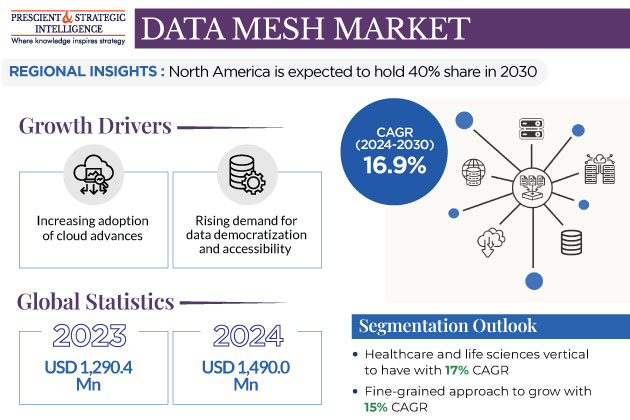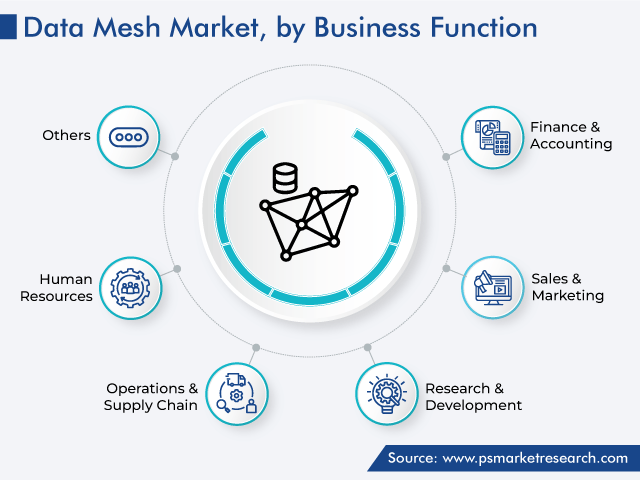Report Code: 12909 | Available Format: PDF | Pages: 260
Data Mesh Market Share Report by Offering (Solutions, Services), Business Function (Finance & Accounting, Sales & Marketing, Research & Development, Operations & Supply Chain, Human Resources), Approach (Fine-Grained, Hybrid Federated, Value-Chain-Aligned, Coarse-Grained), Application (Customer Experience, Data Privacy, Chatbots/Virtual Assistants, Campaign Management, IoT Monitoring), Vertical (BFSI, Healthcare & Life Sciences, Telecom, Retail & E-Commerce, Government & Public Sector, Energy & Utilities) - Global Industry Demand Forecast to 2030
- Report Code: 12909
- Available Format: PDF
- Pages: 260
- Report Description
- Table of Contents
- Market Segmentation
- Request Free Sample
Data Mesh Market Size & Share
The data mesh market revenue was USD 1,290.4 million in 2023, which is expected to witness a CAGR of 16.9% during 2024–2030, reaching USD 3,794.3 million by 2030. The market development is propelled by the rising requirement for data democratization and accessibility, adoption of cloud advances, and existence of rigid security and administrative guidelines. Further, customized data pipelines enable innovation and flexibility as per the exact application and type of business.

Rising Demand for Data Democratization and Accessibility Is Driving Market
The rising demand for data democratization and accessibility is the primary factor driving the market.
- Inside the system of data mesh design, this need implies a shift toward offering different partners across an association reliable and secure access to critical data.
- By democratizing digital information, associations destroy conventional storehouses, thereby cultivating a culture wherein different groups can independently receive, comprehend, and influence information relevant to their jobs and targets.
- This approach enables coordinated efforts, as well as speeds up the decision-making processes by enabling fast access to continuous and contextualized data.
Further, it establishes an environment of data ownership and responsibility in teams, which further drives innovation and efficiency. Such strategies are made to give priority to accessibility, by enclosing data in self-serve, controllable domains, to make sure it is not merely available but also easy to understand and beneficial for all who need it. The market is being driven by the rising demands of companies for flexibility, innovation, and informed decision-making.
- The concept of federated computational governance provides an enormous opportunity in the constantly evolving field of data mesh architecture.
- It leads to a major shift in the way companies handle and govern their distributed electronic information.
- This strategy reflects a decentralized model, where administration is dispersed among different domains inside an organization.
Further, this model aids decision-making and collaboration, while maintaining security, quality, and compliance across interrelated data domains. This way, it makes federated data ownership possible, in which experts of the particular domain are responsible for assuring the security, privacy, and quality of their digital information, unlike with a central governing authority. By creating a sense of ownership and accountability among domain experts and data stewards, this dispersed ownership brings governance techniques closer to the complex details of specific data domains.
- This system ensures uniform metadata standards and governance policies, while bringing metadata management and data cataloging across domains and making it simpler to find and understand information assets.
- This decentralized administration model engages the quick prototyping of new thoughts, enables data-driven navigation, and drives the examination of novel information use cases without compromising on consistency and security standards.
Human Resources Category Is Growing Rapidly
Based on business function, the human resources category is expected to advance a CAGR of 18% from 2024 to 2030 in the market. This is ascribed to the growing concentration on employee-centric programs, which demand more customization and higher awareness of workforce data. HR departments are using these systems to handle the complexity of many electronic knowledge sources, such as skills inventories, performance statistics, and employee engagement measures.
Further, The adoption of AI and ML in this architecture for HR analytics solutions enables the development of advanced predictive analytics models for talent acquisition, employee retention, employee development, performance management, and workforce planning.

Healthcare and Lifesciences Are Fastest-Growing Vertical
Based on vertical, healthcare and life science are expected to be the fastest-growing category, with a CAGR of 17%, over the forecast period.
- The growth of this category is due to a surge in the volume of healthcare data, including genomic information, patient records, and research data.
- Improved integration and analysis across numerous sources of data are enabled by the decentralized structure of the data mesh for diverse domains in the healthcare and life sciences.
In healthcare, decentralized data also allows for better cooperation during clinical trials and research initiatives. Data Mesh principles could improve information sharing among research establishments, pharmaceutical organizations, and care providers. Moreover, the growing trend of healthcare analytics and remote patient monitoring drives the incorporation of data from IoT devices, especially wearables. Data mesh helps in managing the diverse and vast amount of information generated by these devices.
- Many types of healthcare organizations focus on population health management, thereby creating a need for advanced analytics on large datasets.
- Healthcare providers can gain practical insights at scale with the help of this architecture, which has the ability to support distributed analytics.
This decentralized approach can be beneficial for the implementation of health information exchanges (HIEs), which allow for the secure sharing of information about patients among healthcare organizations. Electronic health records (EHRs) are in high demand for decentralized data management, and decentralized digital information access and control architectures help healthcare institutions and departments to deal with such information more independently.
- Extensive data analysis is required in the pharmaceutical industry due to the growing volume of R&D activities for better cures.
- A more-scalable and collaborative method to manage the diverse datasets utilized in these procedures can be supported by data meshes.
- A substantial quantity of electronic information is being generated owing to the growth of telemedicine and remote healthcare services.
- Data meshes help healthcare providers analyze and manage this information effectively, which further supports the delivery of remote healthcare services.
Fine-Grained Category Is Rapidly Growing
Based on approach, the fine-grained approach would have a CAGR of 15% from 2024 to 2030. This approach focuses on complex and granular data management, which enables meeting the advancing necessities of associations for exact and definite data control. Data complexity and diversity are continually increasing, which, combined with the requirement for additional data handling at miniature levels, drives the market.
- Fine-grained data management is important in sectors where regulations are strict, because it provides a more-targeted and controlled approach to compliance.
- This approach is also suitable for ventures that manage different types of electronic information, such as interactive media and data sources from IoT devices.
- It is a boon to numerous organizations that face different data challenges due to its scalability and adaptability.
Data integration can be enhanced by this approach by using more-optimized and specific connections between datasets. This is important in situations where the information needs to be seamlessly integrated into various domains. The adoption of this approach would be driven by the generation of specialized data products designed for specific business units. Consequently, these solutions can be further customized to fulfill the particular requirements of various teams.
| Report Attribute | Details |
Market Size in 2023 |
USD 1,290.4 Million |
Market Size in 2024 |
USD 1,490.0 Million |
Revenue Forecast in 2030 |
USD 3,794.3 Million |
Growth Rate |
16.9% CAGR |
Historical Years |
2017-2023 |
Forecast Years |
2024-2030 |
Report Scope |
Market Trends, Drivers, and Restraints; Revenue Estimation and Forecast; Segmentation Analysis; Impact of COVID-19; Companies’ Strategic Developments; Market Share Analysis of Key Players; Company Profiling |
Segments Covered |
By Offering; By Business Function; By Approach; By Application; By Vertical; By Region |
Explore more about this report - Request free sample
North America Has Largest Share
North America is going to be the largest market, with a share of 40%, in 2030.
- Many companies in this region are adopting the data mesh technology, recognizing its potential to address complex data problems.
- The emergence of specialized platforms and tools customized to these principles is a significant trend.
- These solutions provide decentralized data architectures, which are beneficial for seamless integration, governance, and accessibility across a variety of teams and domains.
Additionally, the region is home to numerous advanced industries, such as healthcare, technology, manufacturing, and finance. The presence of R&D centers and technology hubs, especially Silicon Valley, creates a favorable climate for the adoption of new technologies.
- In North America, the U.S. dominates the market as it is ahead in terms of technological innovation.
- The strong information technology infrastructure in this country offers a solid base for implementing data mesh solutions.
- Moreover, the scalability and performance features of decentralized data architectures are facilitated by an abundance of high-speed internet and advanced computer resources in the country.

Competitive Analysis
The market is seeing a dynamic competitive landscape, with organizations competing to benefit from the rising interest in decentralized data structures. Numerous major players in the market are innovating their tools, platforms, and services to simplify the process of implementing these principles. Further, cloud service providers are altering their products to make them compatible with flexible and scalable infrastructures.
Startups and niche players are also entering the market with innovative solutions that target particular components of data mesh implementation, such as analytics, integration, and governance. Consultancy and advisory organizations are also playing an important role since other firms are seeking to shift to this approach. The overall competition revolves around scalability, domain expertise, technological innovation, and comprehensive support services to meet the demands of diverse companies with respect to decentralized data management.
Recent Developments
- The Cloud Pak for Data (CPD) was launched by the IBM Cloud Pak for Data team in December 2023.
- Oracle Database at Azure was unveiled by Oracle and Microsoft in September 2023 to provide direct access to customers.
- Siemens and IBM expanded their long-term partnership to develop a combined software solution in April 2023.
- SAP launched SAP Datasphere in March 2023. It is a data service developed on the SAP Business Technology Platform (SAP BTP).
Top Providers in Data Mesh Market Are:
- IBM Corporation
- Amazon Web Services Inc.
- SAP SE
- Oracle Corporation
- Informatica Inc.
- K2view Ltd.
- Talend Inc.
- Denodo Technologies Inc
- Hewlett Packard Enterprise Company
- NetApp Inc.
- Teradata Corporation
- Radiant Logic Inc.
- Snowflake Inc.
- Google LLC
- Microsoft Corporation
Market Breakdown
This fully customizable report gives a detailed analysis of the data mesh market from 2017 to 2030, based on all the relevant segments and geographies.
Segment Analysis, By Offering
- Solutions
- Data integration & delivery
- Federated data governance
- Data operations
- Data transformation
- Services
- Managed
- Professional
Segment Analysis, By Business Function
- Finance & Accounting
- Sales & Marketing
- Research & Development
- Operations & Supply Chain
- Human Resources
Segment Analysis, By Approach
- Fine-Grained
- Hybrid Federated
- Value-Chain-Aligned
- Coarse-Grained
Segment Analysis, By Application
- Customer Experience
- Data Privacy
- Chatbots/Virtual Assistants
- Campaign Management
- IoT Monitoring
Segment Analysis, By Vertical
- BFSI
- Healthcare & Life Sciences
- Telecom
- Retail & E-Commerce
- Government & Public Sector
- Energy & Utilities
Region/Countries Reviewed for this Report
- North America
- U.S.
- Canada
- Europe
- Germany
- U.K.
- France
- Italy
- Spain
- Asia-Pacific
- Japan
- China
- India
- South Korea
- Australia
- Latin America
- Brazil
- Mexico
- Middle East and Africa
- Saudi Arabia
- South Africa
- U.A.E.
The industry for data mesh will reach USD 1,490.0 million in 2024.
The data mesh market value will reach USD 3,794.3 million in 2030.
The North American market for data mesh is the largest.
The increasing need for data democratization as well as availability is the key data mesh industry driver.
Healthcare and life science is growing at the fastest CAGR in the data mesh market.
The data mesh industry is observing a dynamic competitive landscape, with players competing to profit from the increasing interest in decentralized data structures.
Want a report tailored exactly to your business strategy?
Request CustomizationWant an insight-rich discussion with the report author?
Speak to AnalystOur dedication to providing the most-accurate market information has earned us verification by Dun & Bradstreet (D&B). We strive for quality checking of the highest level to enable data-driven decision making for you
Our insights into the minutest levels of the markets, including the latest trends and competitive landscape, give you all the answers you need to take your business to new heights
With 24/7 research support, we ensure that the wheels of your business never stop turning. Don’t let time stand in your way. Get all your queries answered with a simple phone call or email, as and when required
We take a cautious approach to protecting your personal and confidential information. Trust is the strongest bond that connects us and our clients, and trust we build by complying with all international and domestic data protection and privacy laws